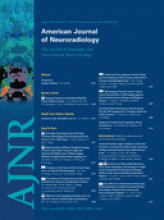Article Figures & Data
Tables
No. of Patients with Data (%)a Stroke in Territory (%) (n = 20) No Stroke in Territory (%) (n = 95) Age (yr) 115 64.05 ± 11.8 66.1 ± 12.9 Sex Male 68 (59) 8 (12) 60 (88) Female 47 (41) 12 (26) 35 (74) Diabetes No 60 (57) 9 (15) 51 (85) Yes 46 (43) 8 (17) 38 (83) Hypertension No 13 (12) 1 (8) 12 (92) Yes 96 (88) 19 (20) 77 (80) Hyperlipidemia No 31 (28) 7 (23) 24 (77) Yes 78 (72) 12 (15) 66 (85) Ischemic stroke No 49 (57) 9 (18) 40 (82) Yes 37 (43) 5 (14) 32 (86) Heart disease No 72 (69) 15 (21) 57 (79) Yes 32 (31) 4 (13) 28 (88) Smoking No 41 (63) 6 (15) 35 (85) Yes 24 (37) 4 (17) 20 (83) -
a Data are not available for all patients.
-
No. of Patients with Data (%)a Stroke inTerritory (%) (n = 20) No Stroke in Territory (%) (n = 95) Days from last symptom to treatment 115 32.8 ± 34.3 66.2 ± 124.2 Treatment Angioplasty 38 (33) 4 (11) 34 (89) BMS 28 (24) 5 (18) 23 (82) WS 49 (43) 11 (22) 38 (78) Presenting mRS at time of intervention 115 (100) 1.8 ± 1.3 1.4 ± 1.1 % Stenosis before primary procedure <70% 7 (6) 1 (14) 6 (86) ≥70% 107 (94) 19 (18) 88 (82) Qualifying event TIA 39 (34) 8 (21) 31 (79) Minor stroke 28 (25) 7 (25) 21 (75) Major stroke 46 (41) 5 (11) 41 (89) Lesion location ICA/VA 46 (40) 6 (13) 40 (87) MCA/BA 68 (60) 14 (21) 54 (79) Lesion morphology Smooth 80 (72) 12 (15) 68 (85) Irregular 31 (28) 8 (26) 23 (74) Concentric 58 (52) 9 (16) 49 (84) Eccentric 53 (48) 11 (21) 42 (79) Ulceration 17 (15) 4 (24) 13 (76) No ulceration 94 (85) 16 (17) 78 (83) Lesion length Short (<5 mm) 44 (40) 5 (11) 39 (89) Moderate (5–10 mm) 17 (15) 5 (29) 12 (71) Long (>10 mm) 50 (45) 10 (20) 40 (80) Activated clotting time at stent deployment 85 (74) 216.2 ± 32.5 217.0 ± 24.9 Time from 1st visit until event (day) 115 (100) 25.9 ± 63.3 269.5 ± 133.2 -
a Data are not available for all patients.
-
- Table 3:
Probability of stroke based on symptom recurrence or repeat intervention at 30 days and 1 year
30 Days 1 Year Significant P Value 95% Hazard Ratio CIs Significant P Value 95% Hazard Ratio CIs Stenting vs angioplasty .031 0.010–0.799 .052 0.041–1.016 Female vs male .062 0.940–12.280 .133 0.776–6.838 Minimal vs maximum no. of days from symptom onset to treatment .066 0.399–1.030 .218 0.527–1.157 Smooth vs irregular lesion .049 0.085–0.995 .074 0.128–1.099 Concentric vs eccentric lesions .121 0.121–1.278 .287 0.200–1.611 Medium/long vs short lesions .145 0.709–10.442 .193 0.680–6.756 - Table 4:
Probability of stroke in the territory based on presenting severity of stenosis and qualifying eventa
Qualifying Event Stenosis 50%–99% Stenosis 50%–69% Stenosis 70%–99% BMC-IRR BMC-IRR WASID BMC-IRR WASID TIA (1 yr) 0.11 (0.05–0.25) 0 0.03 (0.01–0.06) 0.12 (0.05–0.26) 0.14 (0.06–0.22) Stroke (1 yr) 0.25 (0.16–0.38) 0.20 (0.03–0.80) 0.08 (0.04–0.12) 0.26 (0.16–0.40) 0.23 (0.15–0.30) -
a Data are presented as mean probability (95% CI).
-
- Table 5:
Probability of stroke in the territory based on presenting severity of stenosis and qualifying event: TIA, minor stroke, or major strokea
Stenosis 50%–69% Stenosis 70%–99% TIA 1 year 0 0.116 (0.050–0.256) Minor stroke 1 year 1.000 0.212 (0.106–0.400) Major stroke 1 year 0 0.322 (0.166–0.566) -
a Data are presented as mean probability (95% CI).
-
Stenosis 50%–99% Stenosis 70%–99% All interventions: BMC-IRR 0.193 (0.128–0.285) 0.193 (0.127–0.288) Angioplasty 0.125 (0.048–0.301) 0.125 (0.048–0.301) BMS 0.194 (0.085–0.409) 0.202 (0.089–0.424) WS 0.241 (0.140–0.395) 0.241 (0.137–0.404) -
a Data are presented as mean probability (95% CI).
-
- Table 7:
Probability of stroke within 1 year in the territory based on location and intervention type for 50%–99% stenosisa
Nonperforator Vessels (ICA/VA) Perforator Vessels (BA/MCA) Angioplasty 0.091 (0.013–0.492) 0.144 (0.049–0.386) BMS 0.134 (0.034–0.448) 0.333 (0.122–0.718) WS 0.226 (0.079–0.551) 0.246 (0.130–0.434) -
a Data are presented as mean probability (95% CI).
-
Intervention Lesion Location Count Proportion (%) Angioplasty (n = 37) MCA 23 62.2 ICA 7 18.9 BA 3 8.1 VA 4 10.8 BMS (n = 29) MCA 0 0.0 ICA 9 31.0 BA 9 31.0 VA 11 37.9 WS (n = 49) MCA 24 50.0 ICA 10 20.8 BA 10 20.8 VA 4 8.3 Lesion Location BMC-IRR WASID MCA 41.2 32.5 ICA 22.8 21.6 BA 19.3 19.4 VA 16.7 20.3












